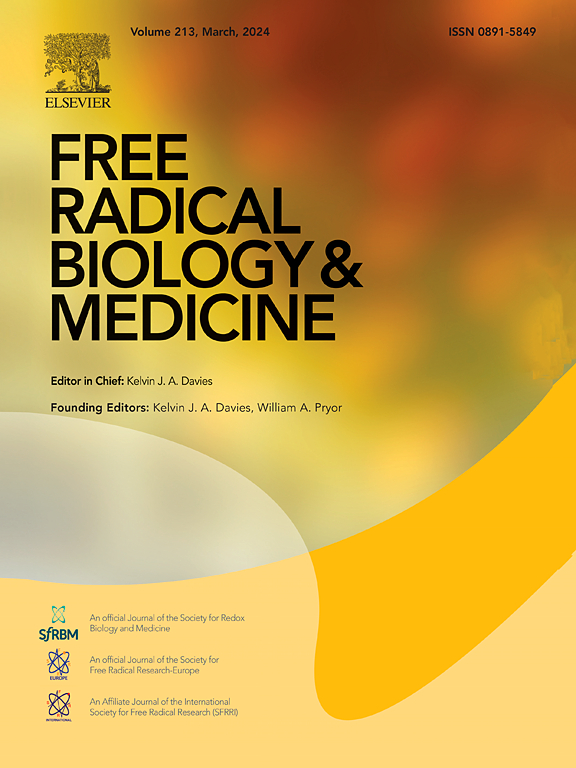Non-enzymatic modification of aminophospholipids induces angiogenesis, inflammation, and insulin signaling dysregulation in human renal glomerular endothelial cells in vitro
IF 7.1
2区 生物学
Q1 BIOCHEMISTRY & MOLECULAR BIOLOGY
引用次数: 0
Abstract
Aims/hypothesis
Advanced glycation end-products (AGEs) formation in proteins are involved in healthy aging and a variety of diseases including Alzheimer's disease, atherosclerosis, and diabetic complications. However, the biological effects of the non-enzymatic modification of aminophospholipids (lipid-AGEs) at cellular level are poorly understood. This study aimed to investigate the effects of lipid-AGEs on angiogenesis, inflammation, insulin signaling, and mitochondrial function in human renal glomerular endothelial cells (HRGEC), exploring their potential role in the pathophysiology of diabetic nephropathy (DN).
Methods
HRGEC cells were exposed to non-enzymatically modified phosphatidylethanolamine (PE) by AGEs (lipid-AGEs), non-modified PE (nmPE) (aminophospholipid without modification), employed as a negative control, and lipopolysaccharides (LPS) as a positive control. Angiogenesis was assessed through vascular network formation metrics, including capillary area, junction density, and endpoints, under different extracellular matrices. Gene expression of inflammatory and angiogenic markers was quantified by RT-qPCR. Insulin signaling components, including IRS1 and AKT phosphorylation, were evaluated by immunoblotting. Mitochondrial function was assessed using high-resolution respirometry to determine ATP production rates from glycolysis and oxidative phosphorylation.
Results
Lipid-AGEs induced dose-, time-, and matrix-dependent angiogenesis, with effects comparable to LPS, particularly in Engelbreth-Holm-Swarm extracellular matrix (ECM) (capillary area increase: 25 %, p < 0.05). Lipid-AGEs significantly upregulated the expression of inflammatory genes IL8 and NFKB (p < 0.05), and the angiogenesis-related markers TGFB1 and ANGPT2 (p < 0.05). Insulin signaling was disrupted, as lipid-AGEs enhanced inhibitory phosphorylation of IRS1 (Ser-1101, 1.8-fold increase, p < 0.01) and modulated AKT (Ser-473) and p42/p44 ERK activation. At lower doses, lipid-AGEs reduced eNOS phosphorylation (p < 0.05) impairing insulin responsiveness. High-resolution respirometry revealed that lipid-AGEs reduced basal oxygen consumption rates (OCR) by 20 % (p < 0.05), with no significant changes in glycolytic ATP production.
Conclusion
Lipid-AGEs induce angiogenesis, inflammation, and insulin signaling disruption in HRGEC, contributing to endothelial dysfunction. These findings underscore the potential role of lipid-AGEs in age-related decline of renal function, as well as the pathogenic potential in DN highlighting their relevance as therapeutic targets for mitigating vascular and metabolic complications in diabetes.

非酶修饰氨基磷脂诱导体外人肾小球内皮细胞血管生成、炎症和胰岛素信号失调
目的/假设蛋白质中晚期糖基化终产物(AGEs)的形成与健康衰老和多种疾病(包括阿尔茨海默病、动脉粥样硬化和糖尿病并发症)有关。然而,非酶修饰氨基磷脂(脂质- ages)在细胞水平上的生物学效应尚不清楚。本研究旨在探讨脂质ages对人肾小球内皮细胞(HRGEC)血管生成、炎症、胰岛素信号传导和线粒体功能的影响,探讨其在糖尿病肾病(DN)病理生理中的潜在作用。方法将shrgec细胞暴露于无酶修饰的磷脂酰乙醇胺(PE)中,以AGEs(脂质-AGEs)、未修饰的PE (nmPE)(未经修饰的氨基磷脂)作为阴性对照,以脂多糖(LPS)为阳性对照。通过血管网络形成指标,包括毛细血管面积、连接密度和端点,在不同的细胞外基质下评估血管生成。RT-qPCR检测炎症和血管生成标志物的基因表达。胰岛素信号成分,包括IRS1和AKT磷酸化,通过免疫印迹法进行评估。使用高分辨率呼吸仪评估线粒体功能,以确定糖酵解和氧化磷酸化产生ATP的速率。结果滑液- ages诱导了剂量、时间和基质依赖性的血管生成,其效果与LPS相当,特别是在Engelbreth-Holm-Swarm细胞外基质(ECM)中(毛细血管面积增加25%,p <;0.05)。脂质年龄显著上调炎症基因IL8和NFKB的表达(p <;血管生成相关标志物TGFB1和ANGPT2 (p <;0.05)。胰岛素信号被破坏,因为脂质- ages增强了IRS1 (Ser-1101,增加1.8倍)的抑制性磷酸化,p <;0.01),调节AKT (Ser-473)和p42/p44 ERK的激活。在较低剂量下,脂质ages降低eNOS磷酸化(p <;0.05)损害胰岛素反应性。高分辨率呼吸测量显示,脂质ages使基础耗氧量(OCR)降低了20% (p <;0.05),糖酵解ATP产量无显著变化。结论脂质age诱导HRGEC血管生成、炎症和胰岛素信号中断,导致内皮功能障碍。这些发现强调了脂质- ages在年龄相关性肾功能下降中的潜在作用,以及在DN中的致病潜力,突出了它们作为减轻糖尿病血管和代谢并发症的治疗靶点的相关性。
本文章由计算机程序翻译,如有差异,请以英文原文为准。
求助全文
约1分钟内获得全文
求助全文
来源期刊

Free Radical Biology and Medicine
医学-内分泌学与代谢
CiteScore
14.00
自引率
4.10%
发文量
850
审稿时长
22 days
期刊介绍:
Free Radical Biology and Medicine is a leading journal in the field of redox biology, which is the study of the role of reactive oxygen species (ROS) and other oxidizing agents in biological systems. The journal serves as a premier forum for publishing innovative and groundbreaking research that explores the redox biology of health and disease, covering a wide range of topics and disciplines. Free Radical Biology and Medicine also commissions Special Issues that highlight recent advances in both basic and clinical research, with a particular emphasis on the mechanisms underlying altered metabolism and redox signaling. These Special Issues aim to provide a focused platform for the latest research in the field, fostering collaboration and knowledge exchange among researchers and clinicians.
 求助内容:
求助内容: 应助结果提醒方式:
应助结果提醒方式:


